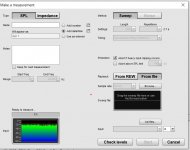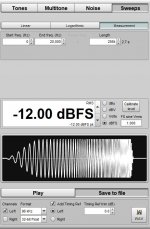Hi Ronald,
Very interesting post to Gassit question!
I think it answer to my own question as i didn't fully get why you were talking about dynamic loss, the buffers and Dac issues.
Ok the 2 last sentence are typical of a lowering of the overall distortion level within your whole system. This isn't surprising as you relieved the array from bass duties, you gain in headroom and lower distortion overall.
My experience about that regarding lowend is it may not be as spectacular as one expect to clean this range at first. But once you are used to it things starts to sound more natural and accurate.
And you soon start to hear better the sound signature of previous elements in the chain.
So i think you just exposed the limit of your Dac whatever they are ( and it seems those are not up to the task of driving lines...).
The loss of dynamic may well be too that the previous distortion level of the array may have 'complemented' the behavior of your dac and made it 'nice' to the brain.
You already had a killer system ( from measurement that is sure anc i never doubt it was the same from the listening side) but now it should be even better!
Have you ever tried to measurd distortion level between sub and without? It could be interesting to see.
Very interesting post to Gassit question!
I think it answer to my own question as i didn't fully get why you were talking about dynamic loss, the buffers and Dac issues.
Hi Gassit,
Bass remains tight and impressive. Now I can play a song like 'A Perfect Circle - Lullaby' full force without worries. I expected to hear a boost in dynamics and clarity due to the arrays being relieved from playing the low frequencies as loud as before. The difference wasn't as big as I had hoped for. That led to an experiment using a pré-amp on the array channels. That change did bring back the dynamic sound and clarity I had experienced before.
Where one can up the volume without it being obvious it is much louder. Until you try to talk to each other...
Ok the 2 last sentence are typical of a lowering of the overall distortion level within your whole system. This isn't surprising as you relieved the array from bass duties, you gain in headroom and lower distortion overall.
My experience about that regarding lowend is it may not be as spectacular as one expect to clean this range at first. But once you are used to it things starts to sound more natural and accurate.
And you soon start to hear better the sound signature of previous elements in the chain.
So i think you just exposed the limit of your Dac whatever they are ( and it seems those are not up to the task of driving lines...).
The loss of dynamic may well be too that the previous distortion level of the array may have 'complemented' the behavior of your dac and made it 'nice' to the brain.
You already had a killer system ( from measurement that is sure anc i never doubt it was the same from the listening side) but now it should be even better!
Have you ever tried to measurd distortion level between sub and without? It could be interesting to see.
I haven't heard differences that amount to the level that wesayso has described them as, but they are there none the less. The differences are more apparent on the arrays than any other speaker I have tried changing amps with, so you have a good test bed.I haven't had the knock me off my horse experience that you have had but I have experiences that hint at it.
I know that good measurements are necessary but not sufficient. But when I experience a good measurement that doesn't sound quite right I wonder what did I fail to measure or overlook in design and analysis. Are my assumptions valid?
The first thing I noticed was Purifi amp had voltage gain of only 12.8 db vs typical 26 db for pro amps.
The other big thing is the Goldmund retained its low THD performance all the way up to its power limit whereas the Purifi is rated at 1% THD. You need to be well below its rating to enjoy its vanishingly low distortion - but that is where we usually are with our relatively high efficiency speakers. Cross a threshold and distortion rises dramatically.
The Goldmund no doubt has a really robust power supply whereas the class D designs typically allow load regulation (voltage drops under load to occur) to increase the peak power capability without a corresponding increase in cost.
The purifi is much like the oem ncore designed to allow an input buffer to bring the gain back to ~26dB in a commercial amp and give the builders a chance to throw some snake oil around and bump the price. Sonic Imagery discrete opamps etc......
Both my current good A/B amps are run off SMPS power supplies, I like them more than transformers and a huge cap bank in my projects. So I don't think that is a real difference, most of the best higher power amps are somewhat power supply agnostic within reason.
I don't think the change between a fraction of a percent and 1% THD will matter that much when feeding 100's of watts into most speakers either.
The thing with the purifi that interests me the most is the claim of significantly reduced inter modulation distortion being largely responsible for the improvements, this is something that is less often measured or easy to interpret when it is.
I have measured distortion with the subs and got plenty of those without subs. However I am waiting to upgrade to that pré-amp before I completely redo my DSP to be able to fine tune. I think I have shown a distortion graph somewhere, let me look it up...
First up: measurement of sub free air, sub inside enclosure and sub with damping material:
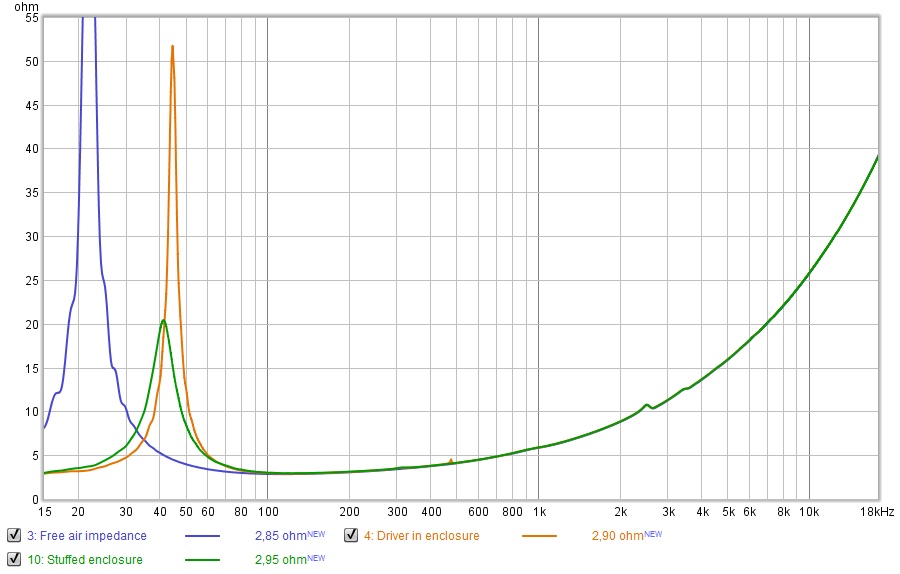
Even more info here: https://www.diyaudio.com/forums/full-range/242171-towers-25-driver-range-line-array-557.html#post6022916
Next, I did a quick align of subs + arrays:
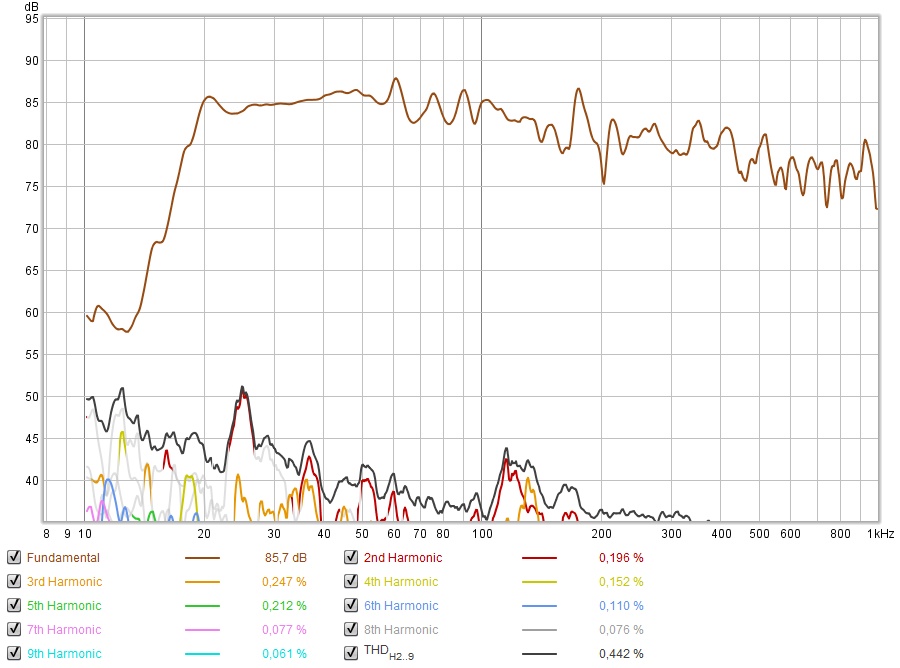
More info here: https://www.diyaudio.com/forums/full-range/242171-towers-25-driver-range-line-array-558.html#post6034599
Basically I EQ-ed the subs flat, made the crossover and some tweaks with RePhase. So I know I can do better. I still need to make a DRC-FIR template for sub duties and do a full session of measurements etc.
These measurements were done while I didn't have the house to myself so I was limited in the amount of sweeps I could do.
Basically I'd like more free time alone to do it properly. However the timing is quite good for a Stereo sum:
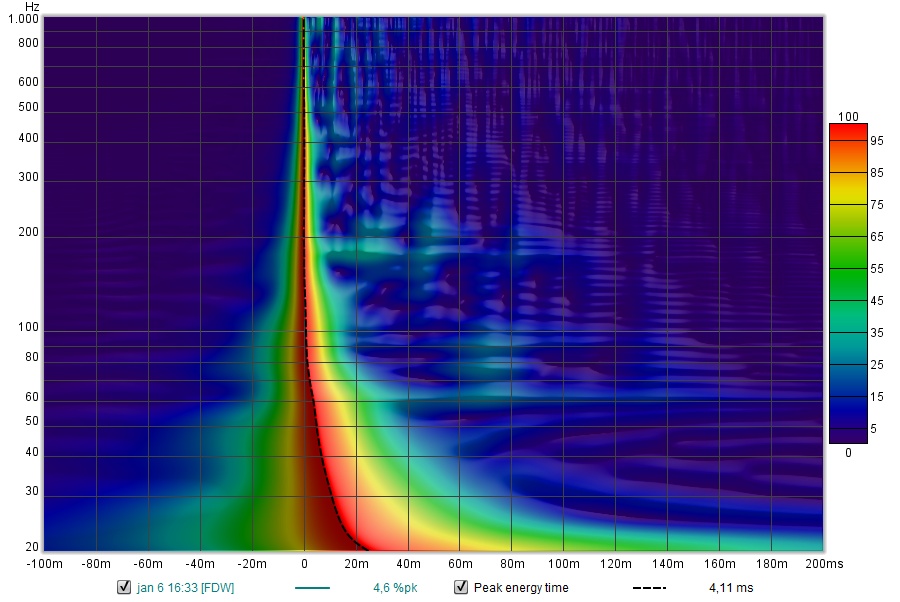
Lots has happened after that, a new Ambience amplifier. The Fetzilla that was part of the get-together of kolby, BYRTT and me had stuck in my mind as being very complementary to the Goldmund sound. So I basically nagged koldby to sell it to me. We've put it into a complimentary enclosure and everything is placed as it was on the Goldmund clone (on front and back) to make it a baby brother amplifier:
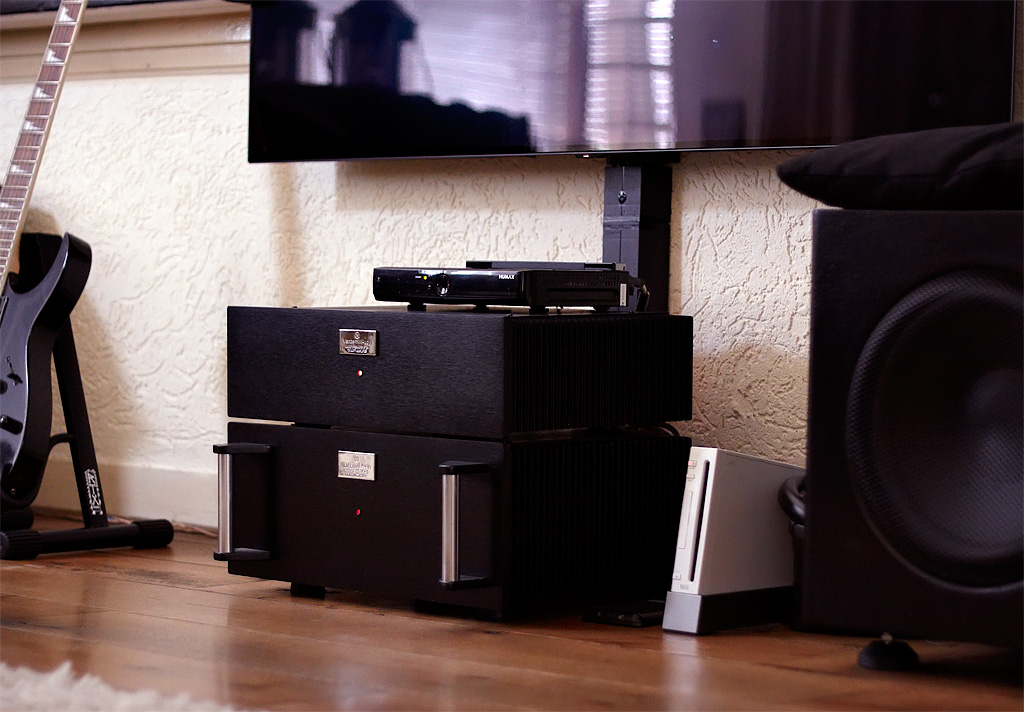
So, that, together with the sub addition does warrant a new full set of measurements of everything to get the best results. But then I added the pré-amp on the mains as an experiment.
Not quite the way I usually do things. I like to change one thing at a time to see what it does. But many things changed (including getting a bigger OLED TV 😉) and it really warrants a revisit of every part of the setup with new measurements. I am delaying that until I get that 6 channel pré-amp in there. For now I do enjoy good sounds, although my Home Theatre setup, which uses an older DSP mix sounds even sweeter than my current Stereo setup. But it is wildly different from the Stereo mix. (using some of the things I learned from the Fixing the Stereo Phantom Center thread)
So I'm sort of in a in-between phase. 😀 There simply isn't enough time in a day/week/month to do everything properly...
Life gets in the way of play time.... In the mean time I use my sparse free moments just to enjoy the system. HT is awesome!
Stereo is quite good and still can give me the chills down the spine. However I do know I can do even better!
First up: measurement of sub free air, sub inside enclosure and sub with damping material:
Even more info here: https://www.diyaudio.com/forums/full-range/242171-towers-25-driver-range-line-array-557.html#post6022916
Next, I did a quick align of subs + arrays:
More info here: https://www.diyaudio.com/forums/full-range/242171-towers-25-driver-range-line-array-558.html#post6034599
Basically I EQ-ed the subs flat, made the crossover and some tweaks with RePhase. So I know I can do better. I still need to make a DRC-FIR template for sub duties and do a full session of measurements etc.
These measurements were done while I didn't have the house to myself so I was limited in the amount of sweeps I could do.
Basically I'd like more free time alone to do it properly. However the timing is quite good for a Stereo sum:
Lots has happened after that, a new Ambience amplifier. The Fetzilla that was part of the get-together of kolby, BYRTT and me had stuck in my mind as being very complementary to the Goldmund sound. So I basically nagged koldby to sell it to me. We've put it into a complimentary enclosure and everything is placed as it was on the Goldmund clone (on front and back) to make it a baby brother amplifier:
So, that, together with the sub addition does warrant a new full set of measurements of everything to get the best results. But then I added the pré-amp on the mains as an experiment.
Not quite the way I usually do things. I like to change one thing at a time to see what it does. But many things changed (including getting a bigger OLED TV 😉) and it really warrants a revisit of every part of the setup with new measurements. I am delaying that until I get that 6 channel pré-amp in there. For now I do enjoy good sounds, although my Home Theatre setup, which uses an older DSP mix sounds even sweeter than my current Stereo setup. But it is wildly different from the Stereo mix. (using some of the things I learned from the Fixing the Stereo Phantom Center thread)
So I'm sort of in a in-between phase. 😀 There simply isn't enough time in a day/week/month to do everything properly...
Life gets in the way of play time.... In the mean time I use my sparse free moments just to enjoy the system. HT is awesome!
Stereo is quite good and still can give me the chills down the spine. However I do know I can do even better!
Last edited:
I forgot to mention some details... this year, before Corona took over our world, we had plans to overhaul our living room. We will get rid of that strange metal ceiling we have, insulate our outer walls from the inside (this house was build in 1927), change out some window frames and upgrade the glass etc. Plans are still in motion, but there's no telling when we get around to all that now.
It's probably a good thing to wait for that room renovation to be behind us before I redo every measurement etc. I'll probably have a lower noise floor and thus get some passive gains as well. That ceiling used to 'sing' with the sweeps when I did the measurements at higher SPL. Especially the raw measurements. True ceiling height in my room might change too, as that metal fixture is lower than the original ceiling was (about ~20 cm). That's going to change up some things too. This renovation has been on our minds since we moved in here... we never got around to it and finally planned it for this year.
It's probably a good thing to wait for that room renovation to be behind us before I redo every measurement etc. I'll probably have a lower noise floor and thus get some passive gains as well. That ceiling used to 'sing' with the sweeps when I did the measurements at higher SPL. Especially the raw measurements. True ceiling height in my room might change too, as that metal fixture is lower than the original ceiling was (about ~20 cm). That's going to change up some things too. This renovation has been on our minds since we moved in here... we never got around to it and finally planned it for this year.
Last edited:
Thank you Wesayso for your answer.
I'll have finished building my house by the end of the year.
And then, I'll finally have the time to build your speakers.
I'll have finished building my house by the end of the year.
And then, I'll finally have the time to build your speakers.
As I've mentioned before, I need my fix, now that I don't do experiments. I've tried to find all I could about the Goldmund Telos history and models.
A snippet:
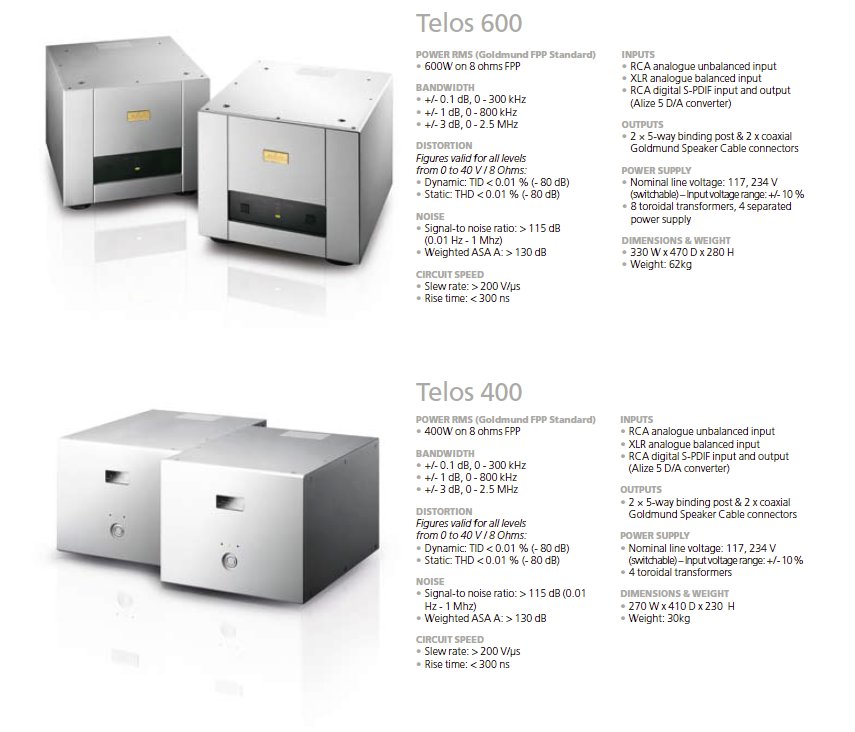
The Telos 5000 is insane though:
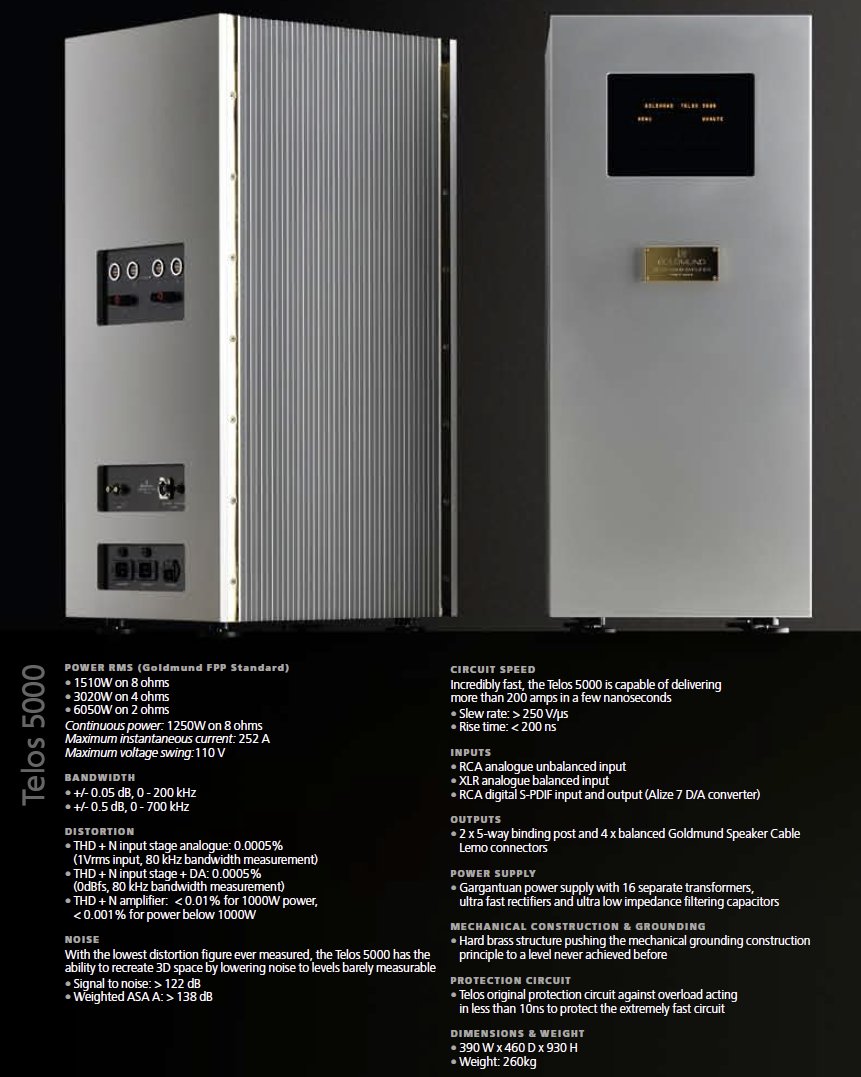
Wow! These babies would be perfect as AM transmitter PA 🙂
But wesayso, you say you miss doing experiments.
What about making a line array that could handle all that Telos power:
Create a cyclinder of 250cm high 50cm diameter fully loaded with the drivers you have in your line-array.
This would end up with 25*16=400 drivers per side!
Wire them up to make a 2 ohm load.
Should be able to handle that 6050 W of continuous power with ease 🙂
Now you also do not need your subs anymore, I am sure this would do >120dB @20Hz....
Last edited:
If I were to do something like that, one amplifier wouldn't suffice...
As that would create the opportunity to use beam steering and would need to use several separate power amplifiers 🙂.
Think:
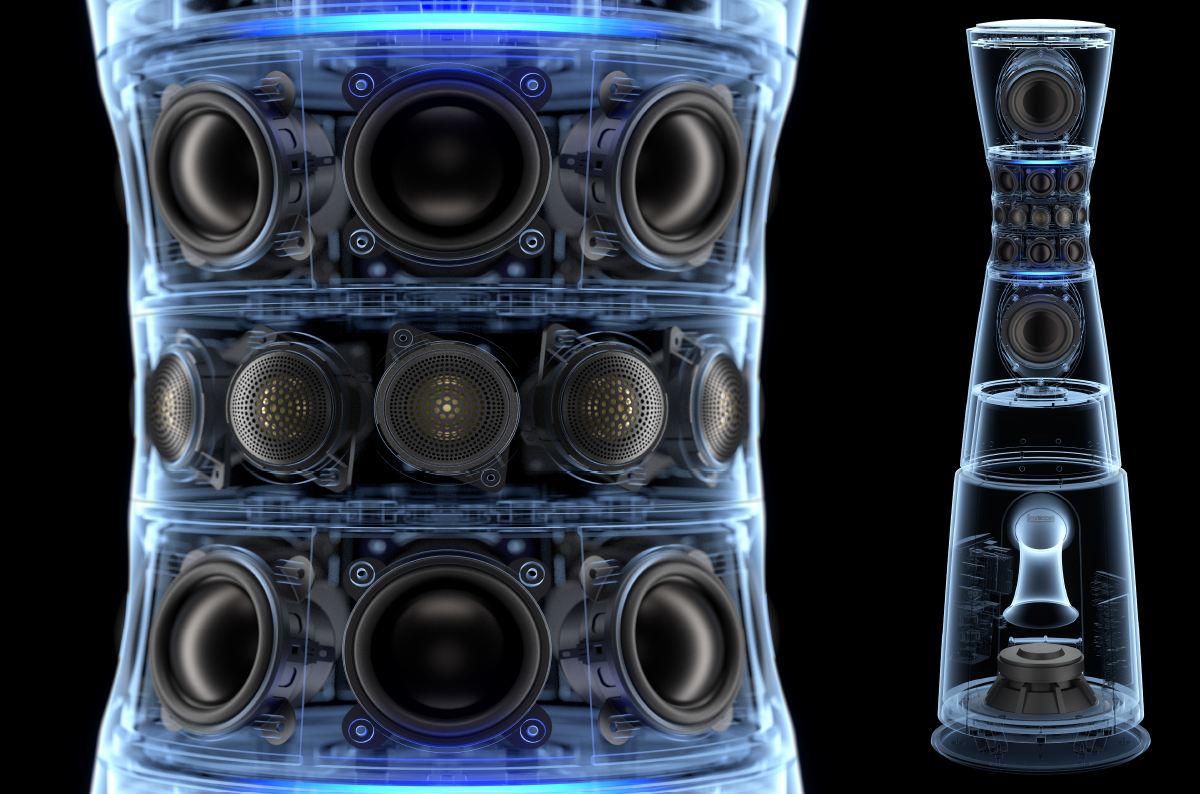
Only a bit bigger...
As that would create the opportunity to use beam steering and would need to use several separate power amplifiers 🙂.
Think:
Only a bit bigger...
If I were to do something like that, one amplifier wouldn't suffice...
As that would create the opportunity to use beam steering and would need to use several separate power amplifiers 🙂.
Think:

Only a bit bigger...
Nice picture but it loses the nice line-array behavior.
So you would then make 16 vertical line arrays mapped as a cylinder each controlled by its own DSP+Amp?
That could give great possibilities!
But it would also be interesting what the radiation pattern would be with all speakers having the same signal.
So you would then make 16 vertical line arrays mapped as a cylinder each controlled by its own DSP+Amp?
That could give great possibilities!
It is the above quote I had in mind... I could have picked the Beolab 90 picture too, to make my point...
But it would also be interesting what the radiation pattern would be with all speakers having the same signal.
Only in real big rooms would I be interested in that...
Omit the floors and ceilings, in a really large space (think: a hanging listening position) and you could make it sphere shaped 😀.
Last edited:
If you built a planar speaker you could hang it on a wall and then you would only need half of a really large space🙂
I guess the way you aim those things is to time them so that the sound from each column arrives at the listener's ear at the same time. Hard to do for the drivers on the rear of the cylindrical array. That would have a different usage model.
Well its fun to dream. Have you thought about embedding more woofage in your ceiling during the remodel?
I guess the way you aim those things is to time them so that the sound from each column arrives at the listener's ear at the same time. Hard to do for the drivers on the rear of the cylindrical array. That would have a different usage model.
Well its fun to dream. Have you thought about embedding more woofage in your ceiling during the remodel?
No extra woofers, not going there 🙂.
Not that I wouldn't want it, but I do want to keep the peace at home. I sneaked in a super short listening session just now while my family members were upstairs, they didn't miss my session 😱.
So what is included in the remodeling is extra damping/isolation between upstairs floor and ceiling...
I was testing the R128 volume leveling on the Roger Waters album Amused to Death. When I was listening to that one on saturday my son came in the room and that made it clear it was playing loud! I mean real loud.
I think that album escapes the R128 algorithm, probably due to the trickery used. I do love what is done on that album. Got the HD version to compare to my CD, no real listening time except a small snippet. I love what is done on those tracks, real crazy.
I was enjoying it too much and forgot to grab the SPL meter, so I didn't even find my answer. 🙄
Not that I wouldn't want it, but I do want to keep the peace at home. I sneaked in a super short listening session just now while my family members were upstairs, they didn't miss my session 😱.
So what is included in the remodeling is extra damping/isolation between upstairs floor and ceiling...
I was testing the R128 volume leveling on the Roger Waters album Amused to Death. When I was listening to that one on saturday my son came in the room and that made it clear it was playing loud! I mean real loud.
I think that album escapes the R128 algorithm, probably due to the trickery used. I do love what is done on that album. Got the HD version to compare to my CD, no real listening time except a small snippet. I love what is done on those tracks, real crazy.
I was enjoying it too much and forgot to grab the SPL meter, so I didn't even find my answer. 🙄
A JRiver and REW loopback question.
Hello all,
I am sorry to ask this here, but as I know some of you guys are experts in REW and JRiver I thought I would take the liberty to ask this off topic question, if I may.
When trying to use 'loopback' in JRiver with REW and my cheap Behringer UCA202's, which normally work happily for playback and testing with both pieces of software using the ASIO4ALL driver, no matter what I do I can not get the input selector boxes in REW to 'activate'. With REW V5.19 Beta 2 I could at least get the 'check levels' signal to play, which I know is playing back through JRiver, when I select it as an ASIO device, as I can manipulate the signal using JRiver's DSP. However, with REW V5.20 Beta 45 it will not even allow me to play the 'check levels' signal, and immediately comes up with a 'Please select the audio input' notification when attempting to.
I realise that probably none of you have ever tried the Behringer UCA202 with REW or JRiver, but I hoped you might have some thoughts I could try. I have tried all input and output options in both REW and JRiver, but as soon as I select JRiver as an ASIO device in REW the input selection boxes are greyed out. Possibly I am completely misunderstanding how these two pieces of software work together in 'loopback' mode? Thanks.
Simon
Hello all,
I am sorry to ask this here, but as I know some of you guys are experts in REW and JRiver I thought I would take the liberty to ask this off topic question, if I may.
When trying to use 'loopback' in JRiver with REW and my cheap Behringer UCA202's, which normally work happily for playback and testing with both pieces of software using the ASIO4ALL driver, no matter what I do I can not get the input selector boxes in REW to 'activate'. With REW V5.19 Beta 2 I could at least get the 'check levels' signal to play, which I know is playing back through JRiver, when I select it as an ASIO device, as I can manipulate the signal using JRiver's DSP. However, with REW V5.20 Beta 45 it will not even allow me to play the 'check levels' signal, and immediately comes up with a 'Please select the audio input' notification when attempting to.
I realise that probably none of you have ever tried the Behringer UCA202 with REW or JRiver, but I hoped you might have some thoughts I could try. I have tried all input and output options in both REW and JRiver, but as soon as I select JRiver as an ASIO device in REW the input selection boxes are greyed out. Possibly I am completely misunderstanding how these two pieces of software work together in 'loopback' mode? Thanks.
Simon
The way I do this to avoid needing to use the Jriver loopback is to measure in REW with the from file option, instructions are here down the page
Making Measurements
Basically save a prerecorded sweep, play it back in Jriver and with the acoustic timing measurement REW knows when the sweep is starting.
I found the loopback to have glitches and clicks in my setup, measuring from file works better for me.
Making Measurements
Basically save a prerecorded sweep, play it back in Jriver and with the acoustic timing measurement REW knows when the sweep is starting.
I found the loopback to have glitches and clicks in my setup, measuring from file works better for me.
Hi fluid.
Thanks for your reply and instructions.
Just a couple of questions if I may? When testing do you run both REW and JRiver on the same system? And, do you loop the sweep file in JRiver then press 'start' in the REW measurement window, making all the correct adjustments in REW for taking measurements from a file of course. Thanks again.
Thanks for your reply and instructions.
Just a couple of questions if I may? When testing do you run both REW and JRiver on the same system? And, do you loop the sweep file in JRiver then press 'start' in the REW measurement window, making all the correct adjustments in REW for taking measurements from a file of course. Thanks again.
I run them on the same computer but you don't have to, you only need to use the same sweep file in Jriver and REW. You could run REW on a laptop and Jriver on another computer.
You start the measurement first in REW and choose the from file option like this
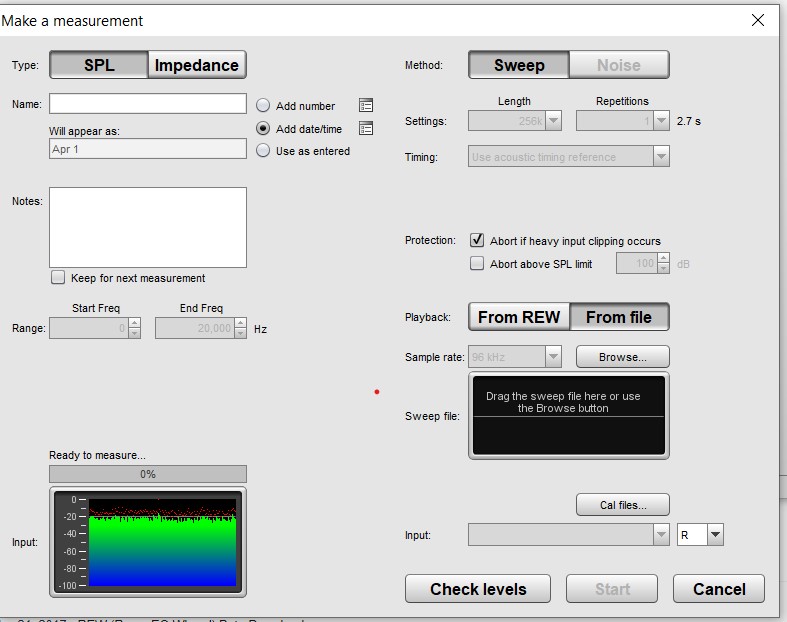
Select the sweep that you are using and press start. The Background window will churn away and it will say waiting for reference or something like that.
You probably will have to move the measurement window over to the right of the screen as it stays on top and will block you selecting the file in Jriver.
Then play the sweep in Jriver, an acoustic timimg reference is embedded in the file, there will be a chirp before the sweep starts.
To generate the sweep go into the generator and select sweep and the measurement tab you can then tick acoustic reference and select the channel it will be embedded in. Choose the sample rate and other options as you normally would have them set.
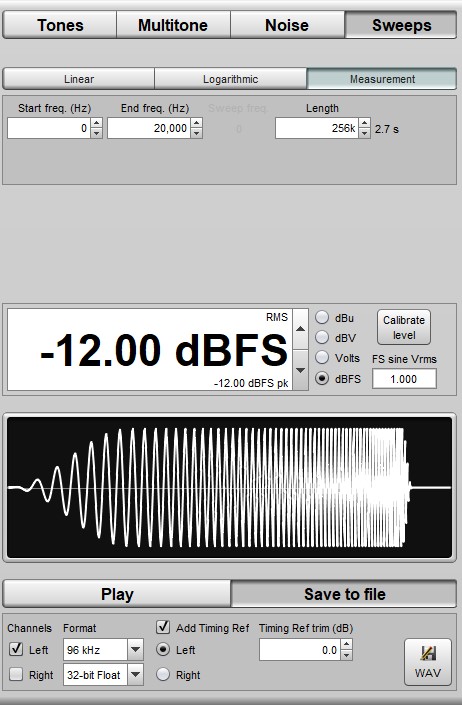
You start the measurement first in REW and choose the from file option like this
Select the sweep that you are using and press start. The Background window will churn away and it will say waiting for reference or something like that.
You probably will have to move the measurement window over to the right of the screen as it stays on top and will block you selecting the file in Jriver.
Then play the sweep in Jriver, an acoustic timimg reference is embedded in the file, there will be a chirp before the sweep starts.
To generate the sweep go into the generator and select sweep and the measurement tab you can then tick acoustic reference and select the channel it will be embedded in. Choose the sample rate and other options as you normally would have them set.
Attachments
Last edited:
Gapmedia, if you will, Please report if the sweep from file was working for you.
I haven't updated to the latest REW, I never keep up entirely, saving the last version that worked well before I do finally upgrade. But it's good to have alternative methods that work.
I haven't updated to the latest REW, I never keep up entirely, saving the last version that worked well before I do finally upgrade. But it's good to have alternative methods that work.
I wasn't looking for it but I stumbled across this interesting differential to single ended converter op amp circuit with gain control. The cool part is it does the control with a single variable resistor, probably similar to the Bruno circuit in that regard. Here is the link
https://www.edn.com/variable-gain-superbal-circuit-preserves-cmrr/
https://www.edn.com/variable-gain-superbal-circuit-preserves-cmrr/
Thanks fluid. I haven't tried measuring yet, but was able to follow your guide with both JRiver and REW open on my Windows 8 laptop using 2x UCA202's. All works as you said, just have to connect the mixer and mic tomorrow and do some actual testing.
More than happy to report back wesayso after all you do around here for us mere mortals. You too fluid.
More than happy to report back wesayso after all you do around here for us mere mortals. You too fluid.
That circuit apparently comes from this eBookI wasn't looking for it but I stumbled across this interesting differential to single ended converter op amp circuit with gain control. The cool part is it does the control with a single variable resistor, probably similar to the Bruno circuit in that regard. Here is the link
https://www.edn.com/variable-gain-superbal-circuit-preserves-cmrr/
Small Signal Audio Design (2nd ed.) by Self, Douglas (ebook)
Unfortunately, the price is $105. Nevertheless, I am tempted.
- Home
- Loudspeakers
- Full Range
- The making of: The Two Towers (a 25 driver Full Range line array)
